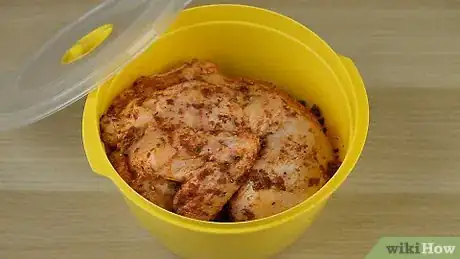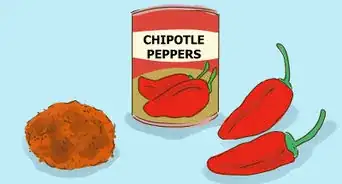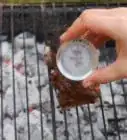This article was co-authored by Alex Hong and by wikiHow staff writer, Hunter Rising. Alex Hong is the Executive Chef and Co-Owner of Sorrel, a New American restaurant in San Francisco. He has been working in restaurants for over ten years. Alex is a graduate of the Culinary Institute of America, and has worked in the kitchens of Jean-Georges and Quince, both Michelin-starred restaurants.
There are 9 references cited in this article, which can be found at the bottom of the page.
wikiHow marks an article as reader-approved once it receives enough positive feedback. In this case, 100% of readers who voted found the article helpful, earning it our reader-approved status.
This article has been viewed 402,537 times.
Dry rubs are mixtures of herbs and spices that you can use to season any kind of meat. If you want to use a dry rub on your chicken, you can easily apply it right before you cook or far in advance. When you’re ready to put the rub on your chicken, work the spices into the meat by hand so you’re able to infuse the flavors. There are many types of dry rubs you can try, so pick one that has a taste you like!
Ingredients
All-Purpose Dry Rub
- ¼ cup (27 g) of paprika
- 3 tablespoons (21 g) of ground black pepper
- 3 tablespoons (20 g) of granulated garlic
- 3 tablespoons (20 g) of onion powder
- 2 tablespoons (6 g) of dried oregano
- 2 tablespoons (6 g) of dried thyme leaves
- 1 tablespoon (17 g) of kosher salt
- 2 teaspoons (3 g) of coriander
- 1 teaspoon (2 g) of cayenne pepper
Sweet and Spicy Dry Rub
- 1 cup (220 g) of brown sugar
- ½ cup (136 g) of kosher salt
- 4 tablespoons (27 g) of smoked paprika
- 2 tablespoons (14 g) of coarse black pepper
- ½ tablespoon (3 g) of cumin
- ½ tablespoon (5 g) of onion powder
- ½ tablespoon (5 g) of garlic powder
- 1 teaspoon (2 g) of cayenne pepper
Herbal Dry Rub
- 2 tablespoons (27 g) of brown sugar
- 2 tablespoons (34 g) of sea salt
- 2 tablespoons (6 g) of dried oregano
- 2 tablespoons (6 g) of dried basil
- 2 tablespoons (6 g) of dried parsley
Lemon Pepper Rub
- 1 tablespoon (7 g) of lemon pepper
- 1 teaspoon (6 g) of salt
- ½ teaspoon (2 g) of garlic powder
- ½ teaspoon (2 g) of onion powder
- ½ teaspoon (0.3 g) of dried basil
- ½ teaspoon (0.3 g) of dried oregano
- ½ teaspoon (0.3 g) of dried parsley
- ½ teaspoon (1 g) of paprika
Spicy Dry Rub
- 3 teaspoons (7 g) of paprika
- 2 teaspoons (2 g) of dried thyme
- 2 teaspoons (8 g) of garlic powder
- 2 teaspoons (12 g) of salt
- 1 teaspoon (8 g) of onion powder
- 1 teaspoon (2 g) of black pepper
Steps
Seasoning Your Chicken
-
1Put the dry rub on the chicken any time before you prepare the meat. Dry rub doesn’t tenderize the meat, so it’s okay to apply it to your chicken any length of time before you decide to cook it. Choose a time to season your chicken when it’s the most convenient for you, whether that’s a week before or the day you plan on cooking.[1]
-
2Pat your chicken dry with paper towels. Make sure the chicken you’re using is completely defrosted before you put your dry rub on it. Take the chicken you plan on seasoning with the dry rub and set it inside a baking pan so you don’t spread any bacteria. Blot paper towels on each side of the chicken to absorb some of the excess juices and contaminants on its surface. Continue patting all sides of the chicken until the paper towels look clean after you blot them.[2]
- Always wash your hands after you handle raw chicken since it contains bacteria that could lead to food poisoning.
Warning: Don’t rinse or wash chicken in your sink before you cook it since you could spread bacteria to other foods, utensils, or surfaces in your kitchen.
Advertisement -
3Drizzle a light layer of olive oil onto the chicken if you want the rub to stick better. Olive oil helps the dry rub adhere to the meat so it’s less likely to fall off while you’re cooking it. Put a coin-sized amount of olive oil on the chicken and spread it evenly across the sides of the chicken. Only use a small amount of olive oil, or else the dry rub will run off the meat and you’ll lose the flavor.[3]
- You don’t need to use olive oil with your dry rub if you don’t want to.
- If you don’t have olive oil, you can use any vegetable oil to help the dry rub stick.
-
4Pour an even layer of the dry rub on each side of the chicken. Use your nondominant hand to scoop the dry rub out from its container and put it directly onto the chicken. You can use as much or as little dry rub as you want, but usually 1 tablespoon (8 g) of dry rub for every 1 pound (450 g) of meat you’re cooking. Make sure you coat all sides of the chicken so the dry rub covers the entire piece of meat.[4]
- Avoid touching the chicken with the spoon you use to scoop if you want to save the dry rub later. Otherwise, you’ll contaminate the dry rub and you’ll need to throw it away.
-
5Work the rub into the chicken with your dominant hand. Apply pressure on the chick with your dominant hand and rub the spices into the meat with a kneading motion. Work with the grain of the meat so the dry rub sticks to all of the hard to reach areas on the chicken. Continue rubbing the spices into all sides of the meat until it’s completely coated.[5]
- Always try to keep one of your hands clean so you don’t accidentally contaminate other surfaces in your kitchen with bacteria.
- You can leave the rub in a 1⁄8 in (0.32 cm) crust on the meat, which will help lock in moisture so your chicken tastes juicier.
-
6Store the chicken in a container with a lid if you don’t plan on cooking it right away. If you don’t plan on cooking your chicken right away, set it in a container that has an airtight lid so bacteria can’t cross-contaminate other items. Put the seasoned chicken in your fridge and use it in about 1-2 days so the meat doesn’t spoil.[6]
- You can also use resealable plastic bags to store your chicken.
- Avoid wrapping your chicken in plastic wrap, since the wrapping could remove some of the rub from the meat.
Choosing a Dry Rub
-
1Use an all-purpose rub in any meal where you want flavorful chicken. An all-purpose rub combines savory and spicy flavors to make a rub that works for any type of cuisine. If you want to make your own, try combining some woody herbs like paprika, black pepper, garlic and onion powder, oregano, thyme, salt, coriander, and cayenne pepper. Whisk the dry rub together until it’s thoroughly combined before storing it in an airtight container.[7]
- You can buy premixed all-purpose rub from your local supermarket or grilling specialty stores.
-
2Choose a sweet and savory dry rub for a classic barbecue flavor. Barbecued chicken usually has a sweet tang, so use brown sugar as the base for your rub. Mix in salt, paprika, pepper, cumin, onion and garlic powder, and cayenne pepper to give your rub more depth of flavor. Adjust the ratios of the rub you’re making so it’s as sweet or tangy as you want it.[8]
Tip: Try mixing in spices with store-bought rubs so you can change the flavor to your liking.
-
3Try an herbal dry rub if you want a simple, fresh taste. Dried herbs work perfectly for seasoning chicken, especially if you want something that highlights the flavor of the meat. Combine equal parts brown sugar, salt, oregano, dried basil, and dried parsley in a mixing bowl and whisk them together to form your rub. Keep the rub in an airtight container to save it for use later.[9]
- Herbal dry rubs work great for Italian dishes.
-
4Mix together a lemon pepper dry rub for hints of citrus and spice. Lemon pepper adds hints of sour and spice to your chicken, and it pairs well with vegetables. Combine lemon pepper, salt, garlic and onion powder, basil, oregano, parsley, and paprika in a bowl and use a whisk to combine them. Keep the spices in an airtight jar or container until you plan on using it.[10]
-
5Season your chicken with a spicy dry rub if you want it to have a little kick. Mix together paprika, thyme, powder, salt, onion powder, and black pepper in a bowl with a whisk until they’re thoroughly combined. A spicy dry rub is perfect if you want to make chicken wings or tacos. [11]
- Use only a little dry rub at first so you don’t make your chicken too spicy.
Community Q&A
Did you know you can get answers researched by wikiHow Staff?
Unlock staff-researched answers by supporting wikiHow
-
QuestionHow long should a dry rub sit on the chicken?
 wikiHow Staff EditorThis answer was written by one of our trained team of researchers who validated it for accuracy and comprehensiveness.
wikiHow Staff EditorThis answer was written by one of our trained team of researchers who validated it for accuracy and comprehensiveness.
Staff Answer wikiHow Staff EditorStaff Answer
wikiHow Staff EditorStaff Answer -
QuestionCan you use a dry rub as a seasoning?
 wikiHow Staff EditorThis answer was written by one of our trained team of researchers who validated it for accuracy and comprehensiveness.
wikiHow Staff EditorThis answer was written by one of our trained team of researchers who validated it for accuracy and comprehensiveness.
Staff Answer wikiHow Staff EditorStaff Answer
wikiHow Staff EditorStaff Answer -
QuestionDo you put dry rub on wings before or after cooking them?
 wikiHow Staff EditorThis answer was written by one of our trained team of researchers who validated it for accuracy and comprehensiveness.
wikiHow Staff EditorThis answer was written by one of our trained team of researchers who validated it for accuracy and comprehensiveness.
Staff Answer wikiHow Staff EditorStaff Answer
wikiHow Staff EditorStaff Answer
Warnings
Things You’ll Need
Seasoning Your Chicken
- Sink
- Paper towels
- Olive oil
- Spoon
- Baking pan
- Container with lid
Choosing a Dry Rub
- Measuring cups
- Measuring spoons
- Whisk
References
- ↑ https://www.foodfirefriends.com/how-to-use-dry-rub/
- ↑ https://rasamalaysia.com/dry-rub-baked-chicken/
- ↑ https://www.simplyrecipes.com/recipes/the_best_dry_rub_for_chicken/
- ↑ https://www.foodfirefriends.com/how-to-use-dry-rub/
- ↑ https://www.foodfirefriends.com/how-to-use-dry-rub/
- ↑ https://www.foodfirefriends.com/how-to-use-dry-rub/
- ↑ https://www.simplyrecipes.com/recipes/the_best_dry_rub_for_chicken/
- ↑ https://www.vindulge.com/ultimate-homemade-dry-rub/
- ↑ https://kissmysmoke.com/italian-herb-rub/
- ↑ https://www.fortheloveofcooking.net/2018/12/lemon-pepper-herb-dry-rub.html
- ↑ https://www.fortheloveofcooking.net/2018/02/spicy-dry-rub-for-chicken.html
- ↑ https://www.cdc.gov/foodsafety/foods-linked-illness.html
- ↑ https://www.fsis.usda.gov/wps/portal/fsis/topics/food-safety-education/get-answers/food-safety-fact-sheets/safe-food-handling/safe-minimum-internal-temperature-chart/ct_index
About This Article
To apply dry rub to chicken, start by defrosting the chicken if you haven't already. Then, dry off the chicken by patting it with a paper towel and sprinkle your dry rub mix over it. Next, using your hands, rub the mix all over the chicken so all of the chicken is coated with an even layer. Finally, cover the chicken with plastic wrap and refrigerate it for at least an hour before cooking it. To learn how to make your own dry rub for chicken, keep reading!


























































